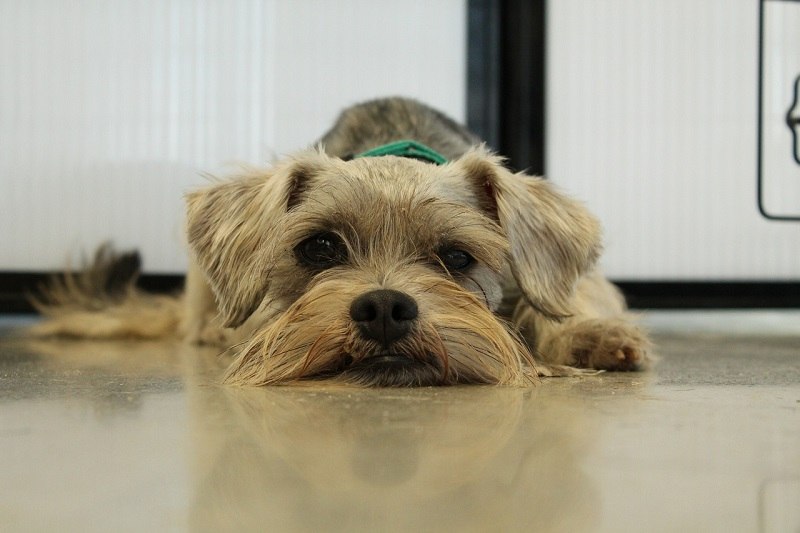Why Is My Dog’s Poop Dry & Powdery? (12 Causes)
Dehydration is when a dog loses more water than it consumes. Dehydration is the most common reason why dogs have dry and powdery poop. Water helps lubricate the digestive tract and keeps your colon smooth and flexible. It gives the intestines an extra push to help “get things moving.” Without water, dogs won’t have regular bowel movements.
Like humans, dogs need to drink water daily, or they experience medical concerns that can turn into serious issues. How To Treat It
The 9 Reasons Why Your Dog’s Poop is Dry and Powdery

Dehydration in dogs is a condition that results when the body doesn’t have enough water to function properly. Dogs may become dehydrated for a variety of reasons, including illness, excessive urination, excessive exercise, vomiting, or exposure to heat or sunlight. One common sign of dehydration is dry, powdery feces. Other symptoms of dehydration in dogs include a lack of energy, lethargy, dry mouth and tongue, and sunken eyes.
Constipation occurs when the dog’s body is unable to supply enough moisture to keep the feces from becoming hard and crusty. Severe or ongoing dehydration can also lead to other, more serious health problems, such as kidney failure. If your dog has dry, powdery poops, make sure they are drinking enough water!
What Do Different Colored Poops Indicate?
Since your dog’s poop color matters just as much as the consistency, let’s discuss what it can mean if the stool is an abnormal color.
Black stool can indicate that there is blood in your dog’s poop, although this is not always the case.
It is also not always the case that blood in the stool will be bright red and readily apparent. Typically, dark, tarry colored poop can mean that there is blood present and that the issue is in the digestive tract, small intestines, or stomach.
Other causes for black stool can be the ingestion of toxins, liver dysfunction, or if you have recently given your dog activated charcoal.

Green poop can be an indication that your dog has rapid bowel transit, which is when the food moves too quickly through the digestive tract. Since it moves so quickly, the liver doesn’t absorb the usual bile.
Green poop can also be the result of eating grass or green-colored dental treats.
As indicated above, white chalky poop signifies an issue with your dog’s gallbladder, intestines, or pancreas. There is a likelihood that the dog’s body is not producing the necessary enzymes that it should be.
Orange stool is a good indicator that your dog has just eaten a large number of carrots that has temporarily turned its poop the same color.
Keep an eye on the color, and if your dog loves carrots, hold off on giving them as a treat until you know whether it is a more severe issue.
It can also be an indication that the dog has pancreatitis, if it is accompanied by other symptoms such as a bloated stomach, stomach pain, and lethargy.
Red poop is likely an indication of blood being present.
If it is bright red blood, it is more than likely due to bleeding in the large intestine or anal glands.
The cause for the bleeding can vary between worm infestation, inflammation of the large intestine lining, or other injuries or causes relating to the large intestine.
Red in the stool can also mean that something is stuck, such a pin, bone, or something else the dog has ingested. The only other reason for red poop is if your dog ate something dark red in significant quantities.
Blood in a dog’s stool can also resemble coffee grounds and appear darker- almost black- if it has been partially digested.
Dog Poop Color Chart: What It All Means
There is a lot of information about your dog’s health that you can get from their poop- and since you are cleaning it up every day, you might as well take a good look to make sure your pup is running at optimal health!
There are many things to consider when collecting your dog’s poop, from the consistency to the color and why it may change from time to time.
If you’ve ever seen your dog’s droppings and wondered, “Why is my dog’s poop dry and crumbly?”, you’ve come to the right place.
Most of the time, dry crumbly poop results from a dehydrated state- either the result of insufficient fiber or liquid intake. A lack of exercise can also contribute to cases of constipation.
Luckily, dry crumbly poop is usually not a serious situation and can be remedied easily by providing more water, exercise, and better diet choices.
However, if your dog has serious constipation where bowel movements are non-existent, or if the poop is white and chalky, it may be a good idea to take it to the vet to check for more serious health issues.
Much like snowflakes, all dog poo is unique and varies from pup to pup- depending on various factors.
A dog’s stool shouldn’t be too soft or too hard. Otherwise, it may be an indication that something is off in the digestive system or intestinal tract. If this is the case, the best thing to do would be to consult a vet ASAP.
Similarly, it is not common for a dog’s stool to be inconsistent in terms of timing and frequency. Dog owners should monitor and keep track of whether their pet has had a bowel movement and note any unusual discrepancies.